IER Activity Log 2020
March 28, 2021 We held the 7th Annual Symposium.

IER holds an annual symposium in March every year to report the research results to the general public and experts and to exchange opinions. The 7th Annual Symposium was held online for the first time in consideration of the spread of the COVID-19 pandemic.
Click here for details.
February 22, 2021 We held the 11th IER seminar.
| Date | Monday, February 25, 2021 14:00–16:00 |
| Topics |
1) The dynamics of Cs-137 in a pond of urban area after decontamination (Honoka Kurosawa, First-year M.S student, Environmental Radioactivity Science Major) 2) Activity concentration of radio caesium and internal radiation doses from self-consumed crops in evacuation order cancellation zone (Mihoko Kikuchi, Second-year M.S student, Environmental Radioactivity Science Major) 3) Using the specific ratio of 137Cs (137Cs/133Cs) to estimate the active root zone of plants (Nguyen Phuong Thoa, Second-year PhD student, Symbiotic Systems Science and Technology Major) 4) Selective separation of technetium-99 from aqueous matrix using solid-phase extraction systems (Md. Ferdous Alam, Second-year PhD student, Symbiotic Systems Science and Technology Major) |
The 11th IER seminar was held on February 22, with 25 attendees including online participants. It was the last IER seminar held in FY2020 (April 2020 to March 2021). Two PhD students and two M.S students from Fukushima University Graduate School of Symbiotic Systems Science and Technology, who are conducting research activities under the supervision of the IER faculty members, made presentations in English on the progress of their respective research.
During the Q & A session, the students received many comments and advice from their supervisors as well as from researchers in different research fields. The students who gave presentations this time will be graduating in March 2022. It seems that they were able to gain meaningful opinions for their master's and doctoral dissertation.
January 25, 2021 We held the 10th IER seminar.
| Date | Monday, January 25, 2021 14:00–16:00 |
| Speakers |
Project Assistant Professor Hiroko Ishiniwa Senior Assistant Professor Shigekazu Hirao Project Professor Alexei Konoplev |
| Topics |
1) Effect of low water level in cooling pond on small mammals inhabiting around Chernobyl nuclear power plant (Ishiniwa) 2) Investigation of Tritium behavior in Okuma (Hirao) 3) Long-term dynamics of radionuclides in rivers and ponds: Fukushima and Chernobyl (Konoplev) |
The 10th IER seminar was held on January 25, with 21 attendees including online participants. We had three speakers: Project Assistant Professor Hiroko Ishiniwa, Senior Assistant Professor Shigekazu Hirao, and Project Professor Alexei Konoplev. This time, two researchers talked about their research conducted under the framework of the SATREPS Chernobyl project, which the IER is working on in Chernobyl in collaboration with Ukrainian research institutes.
Project Assistant Professor Ishiniwa studies the effect of radiation exposure on large Japanese field mice. She talked from the view point of biological and genetic research about the effects of water level drawdown in the cooling pond on small mammals inhabiting around Chernobyl nuclear power plant.
Senior Assistant Professor Hirao, who studies atmospheric transport modelling of radionuclides, talked about his study on the dynamics of tritium in Okuma Town, Fukushima Prefecture.
Since 2015, Project Professor Konoplev has been periodically conducting sampling of water and bottom sediments of some ponds in Okuma Town for his long-term monitoring of the radiocesium concentration. He talked about the dynamics of radionuclides in rivers and ponds/reservoirs and further development of his research on the comparison between Fukushima and Chernobyl.
January 18, 2021 We held the 9th IER seminar.
| Date | Monday, January 18, 2021 14:00–15:00 |
| Speakers |
Project Professor Tatsuo Torii Project Researcher Takahiro Tatsuno |
| Topics |
1) Visualization of environmental radioactivity and gamma-ray imaging (Torii) 2) Effect of dissolved organic matter on Cs migration in a weathered granite soil under water flowing condition (Tatsuno) |
The first IER seminar in 2021 was held on January 18 with 17 attendees including online participants. Speakers were Tatsuo Torii, Project Professor and Takahiro Tatsuno, Project Researcher, who both joined the IER in 2020.
Project Professor Torii, who specializes in radiation measurement, is conducting research on the technology development that can visualize the distribution of radionuclides released and deposited following the nuclear accident. He talked about his latest research on the development of various remote measurement systems such as a drone system and an imaging system that captures gamma-rays emitted from radionuclides.
Project Researcher Tatsuno specializes in migration of radionuclides in the soil environment and soil chemistry. He studies radioactive micro particles in soil and river sediments. In his presentation, he shared his research on the effect of dissolved organic matter on Cs migration in the weathered granite soil under water flowing condition.
December 21, 2020 We held the 8th IER seminar.
| Date | Monday, December 21, 2020 14:00~16:00 |
| Speakers |
Project Researcher Tsutomu Kanasashi Associate Professor Naoto Nihei (Faculty of Food and Agricultural Sciences) Professor Vasyl Yoschenko |
| Topics |
1) Relationships of 137Cs between riparian forests and headwater streams (Kanasashi) 2) Cesium absorption by soybeans / Deposition of resuspended radiocesium (Nihei) 3) Multifaceted effects of chronic radiation exposure in Japanese red pines from Fukushima prefecture (Yoschenko) |
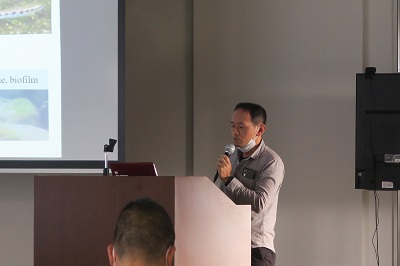 Project Researcher Dr.Kanasashi
Project Researcher Dr.KanasashiThe 8th IER seminar was held on December 21 with 27 attendees. We had three researchers as speakers: Associate Professor Naoto Nihei from the Faculty of Food and Agricultural Sciences, and from IER, Project Researcher Tsutomu Kanasashi and Professor Vasyl Yoschenko.
Dr. Kanasashi, who specializes in forest ecology, is studying the dynamics of radionuclides in ecosystems of the forests and headwater streams. He talked about his research progress on 137Cs migration in the riparian forests and headwater stream areas of Fukushima Prefecture, focusing on the relationship between leaf litters, soil and fishes in the stream.
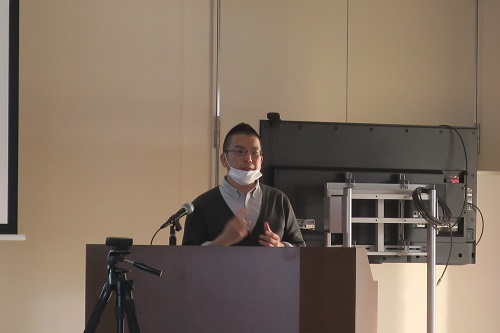 Associate Prof. Nihei from the Faculty of Food and Agricultural Sciences
Associate Prof. Nihei from the Faculty of Food and Agricultural SciencesAssociate Professor Nihei, who specializes in plant nutrition and radiation environmental engineering, talked about his research on cesium absorption of soybeans, focusing on the cesium concentration distribution in a soybean and its genetic aspects. He also talked about the factors that affect radiocesium deposition in Komatsuna (Japanese mustard spinach).
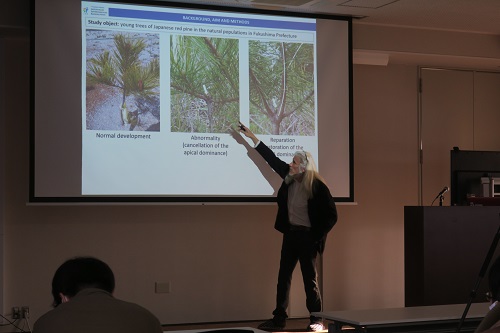 Prof. Yoschenko talking on his latest research
Prof. Yoschenko talking on his latest researchFinally, Professor Yoschenko, an expert in radioecology, talked about the effects of radiation exposure on Japanese red pines in Fukushima Prefecture, focusing on the relation between the changes of plant hormone balance due to radiation exposure and the morphological abnormalities found in Japanese red pines.
Many questions and comments were exchanged by researchers and the last IER seminar held in the year was successfully completed.
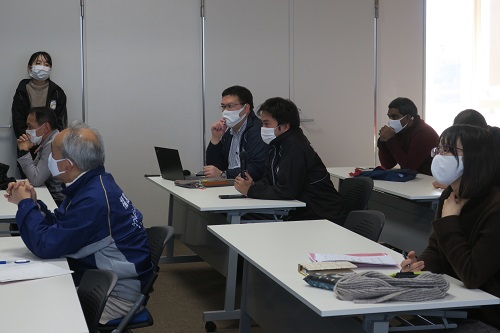
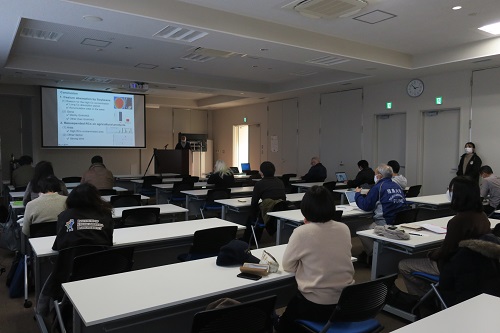
Last seminar of 2020. Best wishes for a safe and happy new year!
December 1, 2020 Students from National Institute of Technology, Fukushima College visited us.
 Research introduction by IER Researcher
Research introduction by IER ResearcherThree students and Professor Mikazu Yui from National Institute of Technology, Fukushima College(Fukushima Kosen)visited IER.
Fukushima Kosen, located in Iwaki City, Fukushima Prefecture, is a national higher education institution consists of a five-year regular course, which provides advanced and specialized education in a wide range of engineering fields, and an additional two-year advanced course that goes on after the regular course. They conduct research activities in cooperation with our faculty members as well. This time, students belong to the 5th year of the Department of Applied Chemistry and Biochemistry of the regular course (equivalent to the 2nd year of university) and the 1st year of the Department of Industrial Technology System Engineering from the advanced course (equivalent to the 3rd year of university) accompanied by Professor Yui visited IER to deepen their understanding about the research activities and the graduate programs of the IER.
 Dialogue session between students
Dialogue session between studentsFirst, Professor Kenji Nanba, the IER director, briefly introduced the establishment history and overview of the IER. Then three researchers, Senior Assistant Professor Shigekazu Hirao, Project Associate Professor Hyoe Takata, and Associate Professor Ismail Rahman, respectively introduced their research in each field: the atmosphere, ocean, and environmental analytical chemistry.
After that, a dialogue session was held between the guest students and three graduate students majoring in Environmental Radioactivity at the IER. In the session, they enjoyed talking about the research and the campus life at the graduate school.
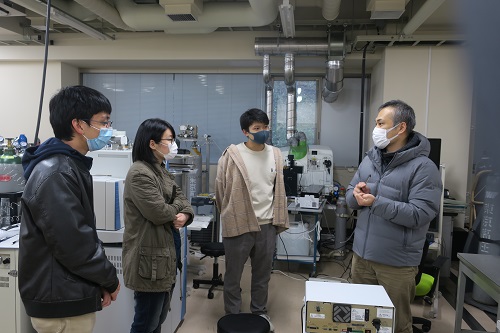 Prof. Takagai talking about his research in analytical chemistry
Prof. Takagai talking about his research in analytical chemistryFinally, Professor Yoshitaka Takagai, an expert in analytical chemistry, showed them around the IER analytical building where many analytical instruments are installed and Faculty of Symbiotic Systems Science building. Professor Takagai, who is also involved in decommissioning technology development, talked about his state-of-the-art research to realize the technology required for nuclear decommissioning work.
 Graduate student explaining analytical devices
Graduate student explaining analytical devicesWe hope that this visit will help them deepen their understanding in environmental radioactivity research at the IER, which has a variety of research fields in the background, and have an interest in studying in our graduate school as well.
November 30, 2020 We held the 7th IER seminar.
| Date | Monday, November 30, 2020 14:00~15:10 |
| Speakers | Associate Professor Ismail Rahman Associate Professor Toshihiro Wada |
| Titles | 1) Selective removal of radionuclides from liquid waste.(Rahman)
2) Uptake and excretion of 137Cs in Japanese dace, a cyprinid fish, under different salinity conditions revealed by rearing experiments using litter-derived 137Cs in water.(Wada) |
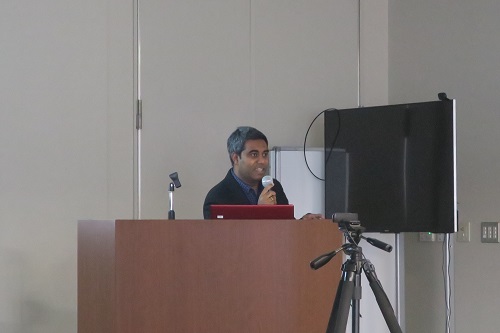 Associate Professor Rahman
Associate Professor RahmanInstitute of Environmental Radioactivity (IER) regularly holds the IER seminar in which the faculty members report on their research results, with the purpose of facilitating their research activities and communication.
The 7th IER seminar was held on November 30 with 29 attendees including web participants. First speaker, Associate Professor Ismail Rahman, a radiochemist who studies environmental remediation and waste management, talked about his research progress on selective removal of radionuclides, particularly strontium, from liquid waste using supramolecular technology.
 Associate Professor Wada
Associate Professor WadaAssociate Professor Toshihiro Wada talked about his research progress. In his research, he developed a fish rearing method using litter-derived 137Cs in water to keep fish contain relatively high 137Cs concentrations, then observed uptake and excretion of 137Cs in Japanese dace* by several experiments under different salinity conditions.
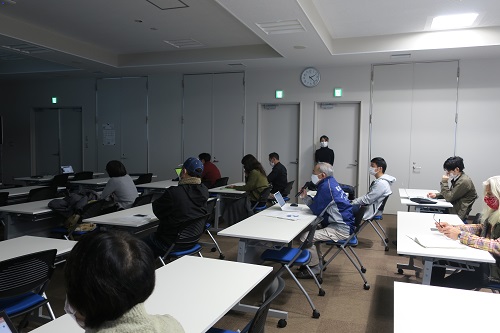
After their presentations, researchers exchanged their views and comments actively.
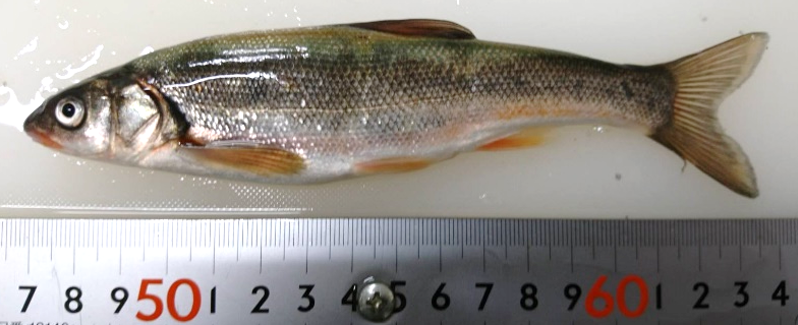 Ugui, a Japanese dace
Ugui, a Japanese dace
*Japanese dace is a common freshwater fish that inhabits inland and coastal waters of diverse water properties in Japan and neighboring countries, which is an ideal model species to study the mechanisms of radiocesium contamination of fishes.
November 27, 2020 We held the 15th Dialogue meeting at Naraha Junior High School

IER held the 15th dialogue meeting at Naraha Junior High School located in Naraha Town, Fukushima Prefecure.
IER has been holding these meetings since 2016, in order to feedback our research results to local communities.
Click here for details.
November 14, 2020 We held the 14th Dialogue meeting in Fukushima City.

IER held the 14th dialogue meeting in Fukushima City.
IER has been holding these meetings since 2016, in order to feedback our research results to local communities.
Click here for details.
November 9, 2020 Members of Senior Network Tohoku visited us.
Senior Network (SNW) Tohoku is the Tohoku branch of SNW of the Atomic Energy Society of Japan. Its activities include holding dialogue meetings with students or residents to disseminate an understanding of energy, nuclear energy, and radiology in a correct manner. The group is mainly composed of retired university faculty members and employees of nuclear-related organizations or electric power company. This time, 9 members of the group visited IER as a part of their study tour.
First, Professor Hirofumi Tsukada explained the background of the establishment of IER and its research activities. Then, they observed the analytical equipment and the archive storage for environmental samples to gain a better understanding of the studies that IER has been working on. After the tour, one of the visitors gave us a comment that they expect us to commit to long-term research activities and human resource development for the next generation.
We hope that this study tour encourages the activities of SNW and helps more people understand the current situation of Fukushima.
October 26, 2020 We held the 6th IER seminar.
| Date | Monday, October 26, 2020 14:00 - 14:45 |
| Speaker | Professor Hirofumi Tsukada |
| Title | Transfer of 137Cs and 90Sr from soil to potato: Interpretation on linking from global fallout in Aomori to accidental released in Chernobyl and Fukushima. |
Institute of Environmental Radioactivity (IER) regularly holds the IER seminar in which the faculty members report on their research results, with the purpose of facilitating their research activities and communication.
The 6th IER seminar of the year was held on October 26 with 21 attendees including web participants. Professor Hirofumi Tsukada is an expert in radioecology who studies the dynamics of radionuclides transfer from soil to crops. He talked about the transfer mechanisms of 137Cs and 90Sr from soil to potato observed in Chernobyl.
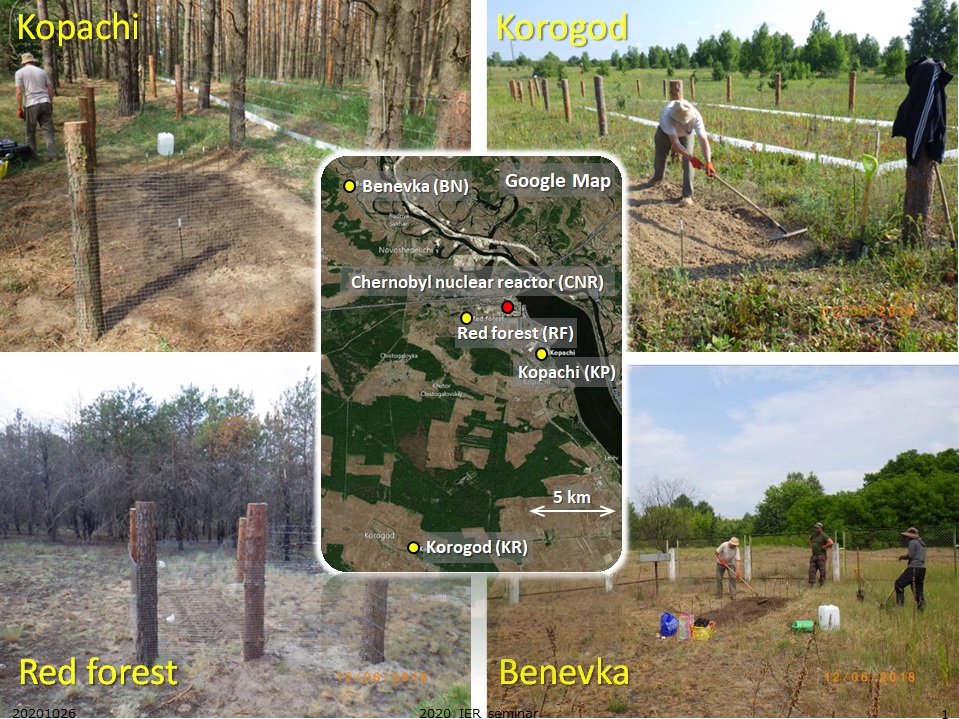 Test fields of potatoes in Chernobyl
Test fields of potatoes in ChernobylSince the Chernobyl accident in 1986, activities in the Chernobyl Exclusion Zone (ChEZ, 30km radius from the power plant) have been severely restricted for over 30 years. Potato is one of the staple foods in Ukraine, but agriculture in ChEZ has not yet been resumed.
Under Japan-Ukraine SATREPS project in 2019, Professor Tsukada and Ukraine collaborators set up observation fields at four locations within ChEZ to investigate the transfer of 137Cs and 90Sr from soil to potatoes. He compared the data obtained in Aomori and Fukushima where the radioactivity in the soil were derived from global fallout and the nuclear accident respectively.
As a result, it was found that the rate of the soil-to-potato transfer of these radionuclides is determined by the amount of K and Ca contained in the soil and also by soil properties. By showing these transfer mechanisms, Professor Tsukada suggested a method to simply and accurately measure the radioactivity concentration in potatoes, whether it is derived from global fallout or a nuclear accident.
Soil-to-crop transfer of radionuclides is an issue closely related to the food safety, which many people are concerned about. Further research results are expected in the future.
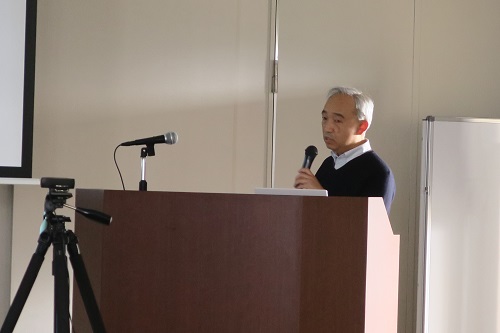
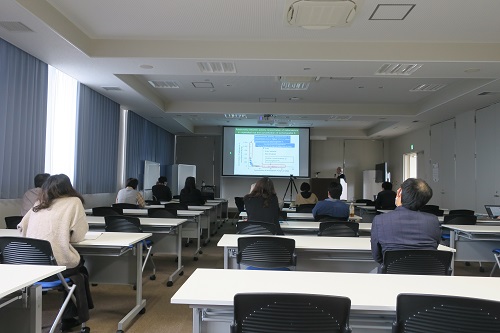
Prof. Tsukada talking about his research results at the IER seminar.
October 8, 2020 Students from Fukushima High School visited us.
Forty students along with two teachers from Fukushima High School visited Fukushima University. Fukushima High School is designated as a “Super Science High School (SSH)” by the Ministry of Education, Culture, Sports, Science and Technology of Japan. Their visit this time was part of their SSH activities, which encourages them to better understand the university and its research activities.
The half-day program started with an introduction of Fukushima University and Faculty of Symbiotic Systems Science and its research activity. Then, the IER Director Kenji Nanba, Project professor Alexei Konoplev, and Project assistant professor Hiroko Ishiniwa respectively gave a 15-minute talk and introduced the IER and their research activities on environmental radioactivity. Students seemed to be deeply impressed with their interesting stories such as their background as a researcher, wild animals as research targets and fieldworks for their research.
After that, students were divided into two groups and had a short tour of the IER analytical building, where we have many kinds of major analysis equipment such as Ge detectors and ICP Mass Spectrometry. They enjoyed exploring the facility with great interest as well as listening to some research trivia told by the IER researchers.
High school students are at an important stage of life where they have to think about their future careers and goals. We truly hope that this tour has become an opportunity for them to expand and increase their interests in learning at Fukushima University.
Students closely paying attention to the talks by Project professor Konoplev (left) and Project assistant professior Ishiniwa(right).
Project associate professor Takata (left) and Director Nanba (right) giving explanations during the tour of the analytical building.
October 3 and 4, 2020 We held a special semimar at Densho-kan in Futaba Town.
| Date | Saturday, October 3 and Sunday, October 4, 2020 |
| Venue | The Great East Japan Earthquake and Nuclear Disaster Memorial Museum “Densho-kan” (Futaba Town, Fukushima Prefecture) |
Institute of Environmental Radioactivity (IER) held a special seminar for university and college students at the Great East Japan Earthquake and Nuclear Disaster Memorial Museum (hereinafter Densho-kan), which newly opened in Futaba Town, Fukushima Prefecture on September 20. Densho-kan displays various records that have been collected since the major earthquake, tsunami and nuclear accident in 2011.
This seminar was organized as a part of educational program within the government-led “Fukushima Innovation Coast Framework” in collaboration with Nagasaki University. It aims for revitalization of the coastal area of Fukushima Prefecture which was seriously affected by the earthquake and nuclear disaster.
talking to students.
The seminar was attended by 24 students studying environmental radioactivity and decommissioning technology of nuclear facility at Fukushima University and National Institute of Technology, Fukushima College. The Director of Densho-kan, Dr. Noboru Takamura, who also serves as Vice Director of IER and Director of Research and Support Center for the Future of Fukushima Nagasaki University, made opening remarks and explained the significance of the establishment of the museum, saying that “learning from the past tragedy leads to preparation for the next generation”. He also encouraged the students to learn a decade of efforts and progress in the environmental radioactivity research in Fukushima ever since the disaster.
The two-day program included the introduction of the latest research by eight IER researchers, a visit to the Densho-kan exhibition, a half-day tour of the interim storage facility and Futaba Town where revitalization projects are going on, as well as presentations and group discussion by students.
Students listened carefully to the researchers from respective research field, learning their state-of-the-art studies. In the facility tour, they had opportunities to communicate with local people in person and faced the memories and reality of the nuclear accident. In group discussion at end of the seminar, all the students picked up some keywords which impressed them through the lectures and the facility tour, and shared their thoughts and feelings with others.
We got many encouraging comments from the students participated in the seminar, such as “the sad experience of the people suffered from the tsunami and nuclear accident was vividly conveyed from the exhibition of Densho-kan”, “I got to know the reality and problems that people affected by the disaster are still facing”, “it was a good opportunity to exchange our thoughts with other students”, and “this seminar has motivated me a lot toward the future”. It seemed that the seminar has helped participants increase awareness of the issues.
We are glad that the seminar became a valuable opportunity for the students to broaden their interests in the study of environmental radioactivity in Fukushima and revitalization of the affected areas. It was also meaningful for us to hear the voices of the students directly. We will continue to create such opportunities where we can disseminate our research results and interact with students, for the sake of revitalization of the coastal areas of Fukushima Prefecture.
Group photo of the participants.
October 2, 2020 We held a IER special seminar.
| Date | Friday, October 2,2020 14:00 - 15:10 |
| Speaker | Dr. Noriyuki Momoshima
Professor emeritus of Kyushu University President of Kyushu Environmental Evaluation Association |
| Titles | Tritium in the environment |
IER holds IER special seminar several times a year inviting external speakers, which has been suspended this fiscal year due to the COVID-19 pandemic. However, on October 2, we finally had an opportunity to hold the seminar with a guest speaker from Kyusyu. In light of preventing the spread of COVID-19, the seminar was carried out with measures such as taking attendees’ body temperature, disinfecting desks and chairs, and asking participants to wear masks and disinfect their hands.
The seminar was co-hosted by Fukushima Environmental Measurements and Radioactivity Monitoring Association and we invited Noriyuki Momoshima, Professor emeritus of Kyushu University, as a speaker who also serves as the President of Kyushu Environmental Evaluation Association. The lecture titled “Tritium in the environment” was attended by 38 people at the venue and 15 others online.
The lecture was 70 minutes long and had a wide range of topics on tritium including the production mechanism, environmental dynamics, amount released from nuclear power plants, and concentration in the environment. Since the management of the tritiated water at TEPCO Fukushima Daiichi Nuclear Power Plant has been a controversy, the attendees were enthusiastically listening to and learning from Dr. Momoshima’s lecture which contained plenty of useful information and knowledge.
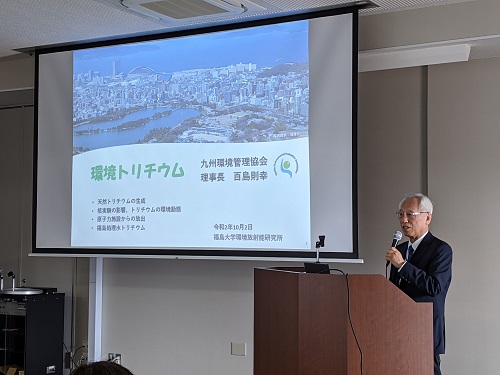
Dr. Momoshima giving a lecture on tritium.
September 30, 2020 We held the fifth IER seminar.
| Date | Wednesday, September 30, 2020 14:00~16:00 |
The fifth IER seminar of the year was held on September 30 with 28 attendees. In this seminar, six master’s students in their second year of Environmental Radioactivity Science Major, Graduate School of Symbiotic Systems Science and Technology made presentations on their research progress in English.
After their presentations, a lot of comments and advice were given by their supervisors as well as other researchers from different fields of research. Students were answering carefully to each question and comment.
They are the first students entered in the first year the Master’s program of Environmental Radioactivity Science Major was launched at IER. We hope that they will do their best to succeed in culminating their dissertation research and completing the program.
| Titles |
1) Radiocesium concentrations in experimentally cultured carp, other fish, and sediments of an irrigation pond in Koriyama City (Misaki Usuki) 2) Studies on the effective dose for public based on air dose rate (Yuya Endo) 3) Detection of 60Co released from the 2011 Fukushima Daiichi Nuclear Power Station accident (Yusuke Okizawa) 4) Accumlation of radiocaesium in bryophytes (Chieko Otsuki) 5) Temporal variation in 137Cs in the Niida river catchment during rainstorm events (Takuya Niida) 6) Evaluation of vegetation index in Abukuma river basin for estimation of soil erosion (Edea Loa) |
Graduate students giving presentation in the seminar.
September 28, 2020 We held the fourth IER seminar of the year.
| Date | Monday, September 28,2020 14:00 - 14:30 |
| Speaker | Project associate professor Hyoe Takata |
| Title | Suspended particle−water interactions increase dissolved 137Cs activities in the nearshore seawater during Typhoon Hagibis. |
Institute of Environmental Radioactivity (IER) regularly holds the IER seminar in which the faculty members report on their research results, with the purpose of facilitating their research activities and communication.
The fourth IER seminar was held on September 28 with 25 attendees. Speaker of the day was Project assistant professor Hyoe Takata, who is an expert in Marine chemistry and Geochemistry. He talked about his latest research output: Suspended particle−water interactions increase dissolved 137Cs activities in the nearshore seawater during Typhoon Hagibis.
In the nearshore sea area of Fukushima Prefecture, the 137Cs concentration in seawater still remains higher than before the nuclear accident in 2011. Professor Takata hypothesized that one of the factors of this situation can be attributable to the river water inflow. Examining the nearshore seawater of Fukushima Prefecture collected between June and October in 2019, he found that the concentration of dissolved 137Cs in seawater was increased after the passage of Typhoon Hagibis in October 2019 compared to before that. The result obtained from analysis of the collected seawater and past laboratory experiments suggested that it is due to the 137Cs contained in river sediments being dissolved in the seawater during the typhoon event. Moreover, the river influence was suggested by a model verification as well.
Professor Takata has announced these research findings at the press conference of Fukushima University held on September 2, which was subsequently spotlighted in newspapers and TV news. The attendees listened carefully to his presentation and had active interactions afterwards.
Project associate professor Hyoe Takata talking about his latest research findings.
Questions and comments were given by researchers.
September 15, 2020 We held the third IER seminar of the year.
| Date | Tuesday, September 15,2020 14:00 - 16:00 |
| Speakers | Shota Moritaka (Second-year M.S student, Major of Environmental Radioactivity Science, Graduate School of Symbiotic Systems Science and Technology, Fukushima University) Donovan Anderson (Third-year PhD student, Major of Symbiotic Systems Science and Technology, Graduate School of Symbiotic Systems Science and Technology, Fukushima University) |
| Titles |
1) Seasonal fluctuation of Cs-137 concentration and water quality in Abukuma River revealed by long-term monitoring (Moritaka) 2) The 2011 Tohoku disaster’s impact on wild boar populations within Fukushima Prefecture: Genetic and radiological contamination (Anderson) |
The third IER seminar of the year was held on September 15 with 28 attendees. This time, the M.S and PhD candidates from the Graduate School of Symbiotic Systems Science and Technology respectively reported their research progress updates.
First, Shota Moritaka, a second-year M.S candidate, who studies the dynamics of radioactive cesium in river water, made a progress report on his research on the seasonal fluctuation of Cs-137 concentration and water quality in Abukuma River, Fukushima Prefecture, based on the analysis of long-term monitoring results for eight years. He presented the research results on the correlation between the seasonal fluctuation of dissolved Cs-137 concentration in the river water and the elution of dissolved Cs-137 from “Shirokaki” (preparation process of paddy fields before rice planting), and from litter of the forest.
The next speaker, Donovan Andersen, a third-year PhD candidate and Japan government-sponsored student from the U.S, who studies radioecology, genetics, and radiation biology at Fukushima University, reported on the progress of his research on the 2011 Tohoku disaster’s impact on wild boar populations within Fukushima Prefecture from the points of view of genetic and radiological contamination. Having investigated 338 wild boar within the prefecture, his study confirms introgressive hybridization of local wild boar populations with released domestic pig populations in the difficult-to-return zone. In the study of radiation induced effect on wild boar, no current research nor his study indicate deleterious effects (dicentric chromosome aberration) due to radiation exposures in Fukushima boar.
In the feedback session, many productive questions and comments were given for both studies.
Shota Moritaka (left) and Donovan Andersen(right) talk on their research progress.
Many productive questions and comments were given for both speakers.
August 31, 2020 We held the second IER seminar of the year.
| Date | Monday, August 31, 2020 14:00 - 16:00 |
| Speakers | Senior Assistant Progessor Yoshifumi Wakiyama Project Professor Mark Zheleznyak |
| Titles |
1) Dynamics of 137Cs in the Abukuma river catchment due to the typhoon Hagibis.(Wakiyama) 2) Distributed modeling of radionuclide washing out from the watersheds in solute and with suspended sediments: case studies Abukuma River, Fukushima Prefecture and Pripyat Dnieper river system, Ukraine (Zheleznyak) |
Institute of Environmental Radioactivity (IER) regularly holds the IER seminar for the faculty members to report on their research results, with the purpose of facilitating communication and the research activities among the members.
On August 31, we held the second IER seminar of this fiscal year with 27 attendees (including online participants) while taking precautions against COVID-19.
First, Senior Assistant Professor Wakiyama, an expert in hydrogeomorphology, gave a talk on the dynamics of 137Cs in the Abukuma River catchment of Fukushima Prefecture during the passage of Typhoon Hagibis. This massive typhoon hit Japan in October, 2019, has triggered flooding of rivers at many places, causing widespread damage across the country. During the freshet caused by the typhoon, Professor Wakiyama did sampling of river water at a downstream point of Abukuma River. Then he analyzed the samples and estimated the amount of 137Cs wash-off from the catchment. He also indicated that the spatial distribution of 137Cs in the floodplains was changed due to Typhoon Hagibis, according to the results of the survey on the vertical distribution of 137Cs conducted at the six floodplains in the catchment in October, 2018 and October to December, 2019.
The next speaker was Project Professor Zheleznyak, an expert in radiological hydrology who mainly studies the modeling of radionuclide transport in surface waters after Chernobyl and Fukushima Daiichi accidents. He gave a talk on the distributed modeling of radionuclide washing out from the watersheds in solute and in suspended sediments along with the case studies of Abukuma River, Fukushima Prefecture and Pripyat Dnieper River, Ukraine.
It was an valuable seminar where the speakers and attendees exchanged their views and comments in a lively Q and A session.
Prof.Wakiyama (left) and Prof.Zheleznyak (right) giving research talks.
IER researchers exchanged their views and comments at the seminar.
August 3, 2020 Students from Asaka High School visited us.
Five students from Asaka High School visited the IER.
Asaka High School is designated as a “Super Science High School (SSH)” by MEXT. As part of the activity as a SSH, they are working on a project with a theme of “community creation”, in which they aim to find solutions for regional issues and to create new values of the community. Hoping to learn about the radioactive contamination of crops and the countermeasures against harmful rumors, one of the students contacted us, which led to their visit for the tour.
In order to cover their request, Professor Hirofumi Tsukada from the IER gave a talk about the radioactive contamination of crops and Professor Ryota Koyama from the Faculty of Food and Agricultural Sciences talked about the countermeasures against harmful rumors.
Prof. Tsukada explained the scientific mechanism of radiocaesium transfer from soil to rice, while Prof. Koyama told about the low price of Fukushima-grown Wagyu beef and rice in 2020, nine years following the nuclear accident, which was caused not only by the harmful rumors, but also by a market structure problem caused after the Fukushima accident. The students listened to the lectures very carefully and seriously even though they contained technical terms, which would have been difficult for high school students.
At the end of the tour, they observed Ge detectors and learned how the analyses of environmental samples such as soil, water, and crops are processed.
The students said that they were too young (just before entering elementary school) to remember the earthquake and nuclear accident occurred in 2011. We hope that their visit to the IER will motivate them to learn more about the various issues of Fukushima and also to acquire a scientific perspective.
Lectures by Prof. Tsukada (left) and Prof. Koyama (right)
Students observing the Ge detectors (left) Thank you for visiting us! (right)
July 27, 2020 We held the 1st IER seminar of the FY2020
| Date | Monday, July 27, 2020 14:00 - 16:00 |
| Presenters | IER Director Kenji Nanba Project Assistant Professor Yasunori Igarashi |
| Titles |
1) Estimation of catchment scale water balance at Chernobyl in Ukraine using long-term field observations and model simulations.(Igarashi) 2) Strengthening of the environmental radiation control and legislative basis in Ukraine for the environmental remediation of radioactively contaminated sites.(Nanba) |
Institute of Environmental Radioactivity (IER) regularly holds research results reportings by faculty members as “IER seminar”, which aims to facilitate the communication among the faculty members and to progress their research.
On July 27, we held the first IER seminar of the fiscal year 2020 after some suspending periods due to the COVID-19 situation. We had 33 attendees (Online participants included) at the seminar which went on under careful preventive measures for the infection, such as adequate ventilation, wearing masks, and ensuring the distance between attendees.
Project Assistant Professor Yasunori Igarashi and IER Director and Professor Kenji Nanba gave presentations in regard to the SATREPS Chernobyl project (Click here for the project details), on which IER has been working since 2017 with other institutes in Ukraine.
Project Assistant Professor Igarashi, an expert in forest hydrology, gave a talk on the estimation of catchment scale water balance in Chernobyl, Ukraine using long-term field observations and model simulations. He has so far successfully modeled the long-term changes in strontium 90 (Sr-90) concentrations in the rivers in Chernobyl exclusion zone, confirming that there is a clear correlation between Sr-90 and the river flow. He announced about this achievement at the press conference held on July 1, 2020.
In this presentation, he demonstrated the accurate prediction of river flow rate that greatly contributes to the evaluation of the radionuclides discharge including Sr-90, and suggested their potential changes that the future climate changes may cause.
IER Director Nanba followed, making a presentation on the interim report of the SATREPS Chernobyl project. This 5-year project, in which most of the IER researchers participate, has just passed its halfway point. At the moment, it is difficult to conduct research at the local sites due to the COVID-19 situation, however, the research activities are progressing in cooperation with the research institutes in Ukraine. The attendees closely listened to the presentation that covered a wide range of research targets of the project.
(Left)Project Assistant Professor Igarashi (Right) IER Director Nanba
(Left) At the IER seminar. (Right) IER researchers making comments.
